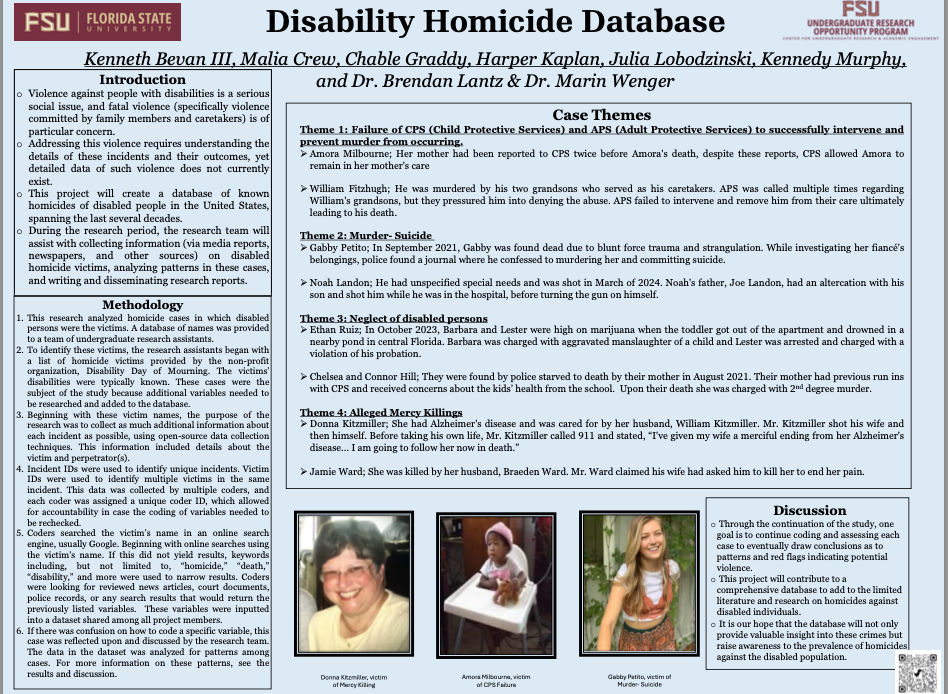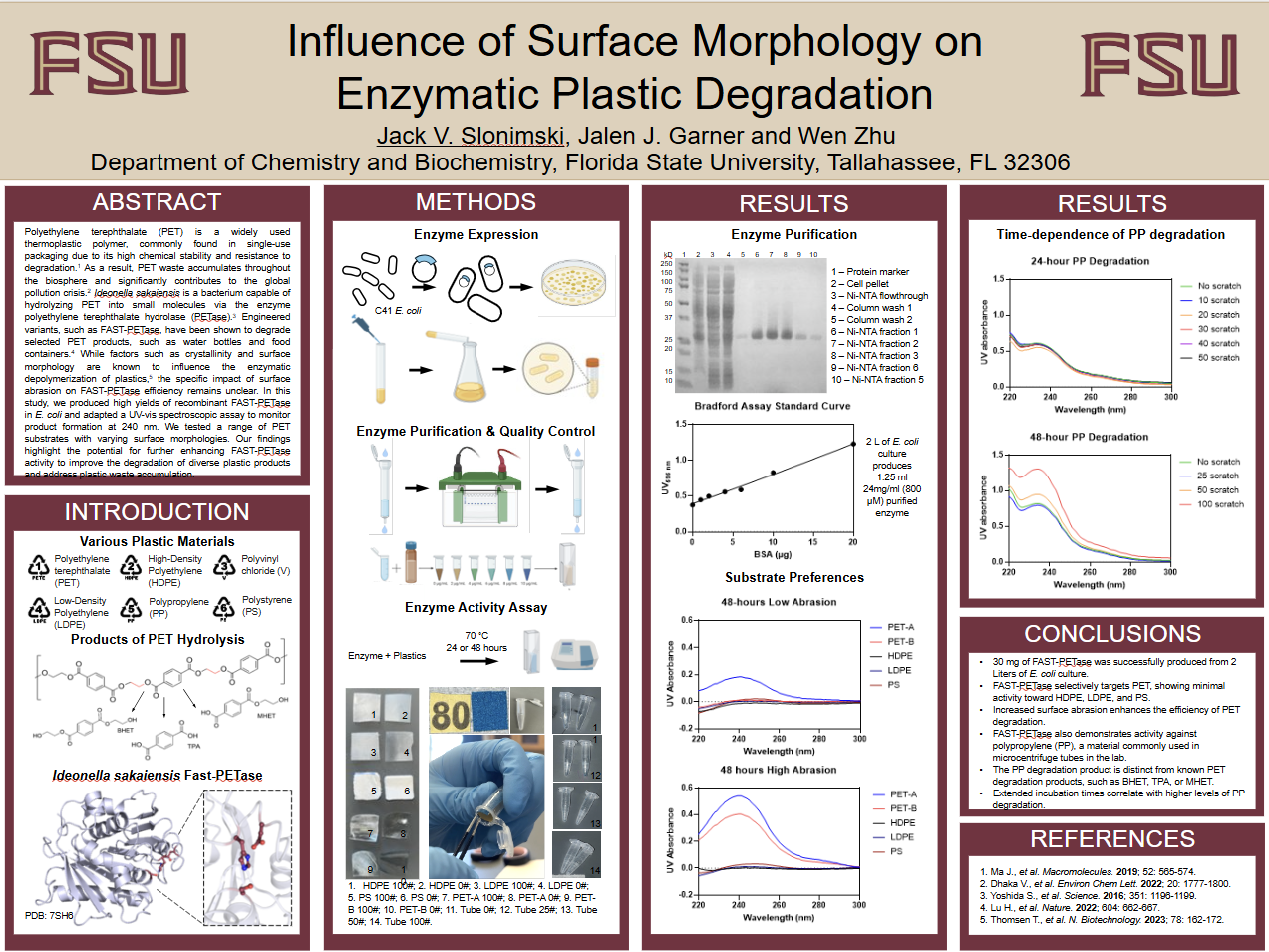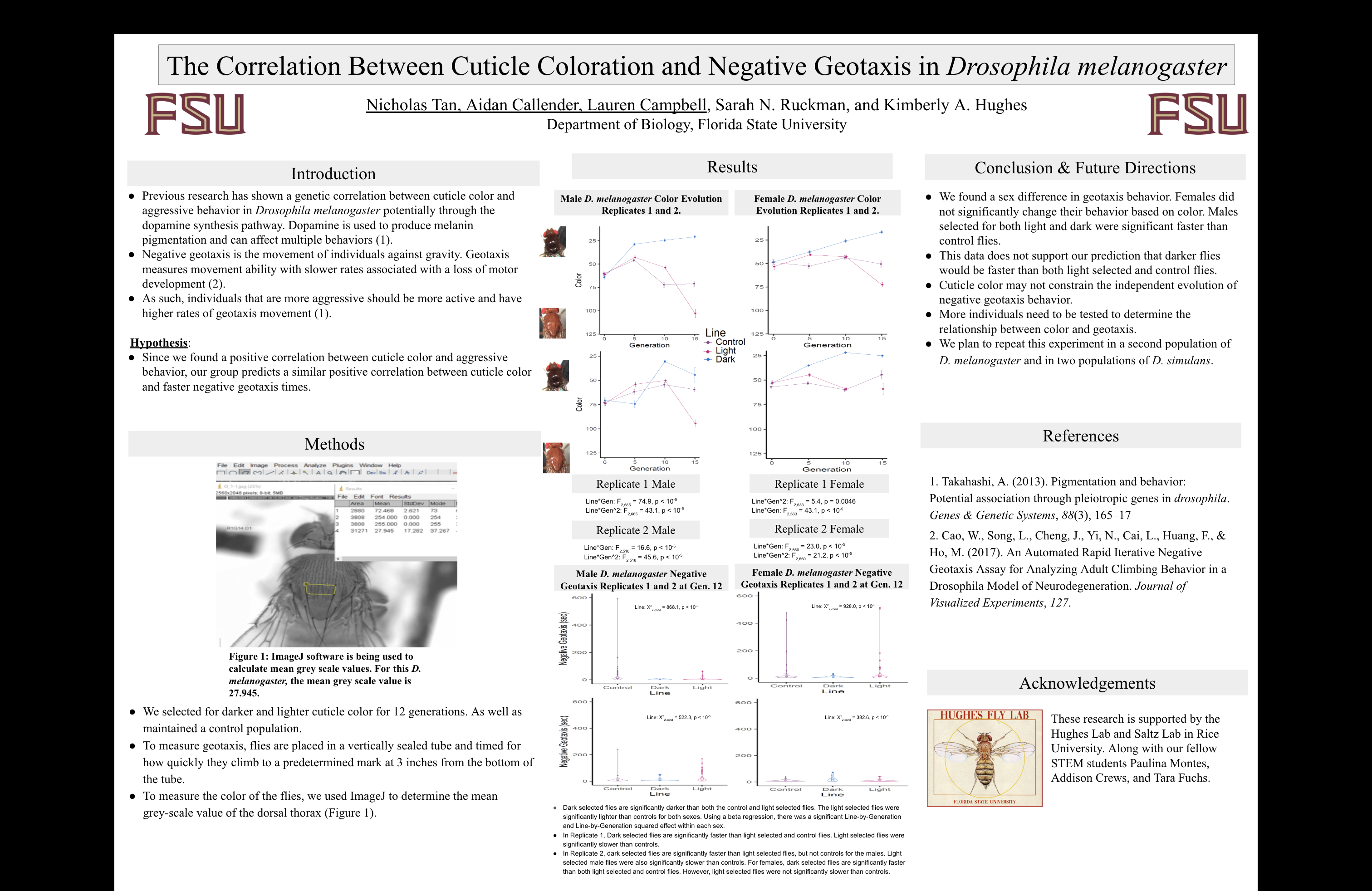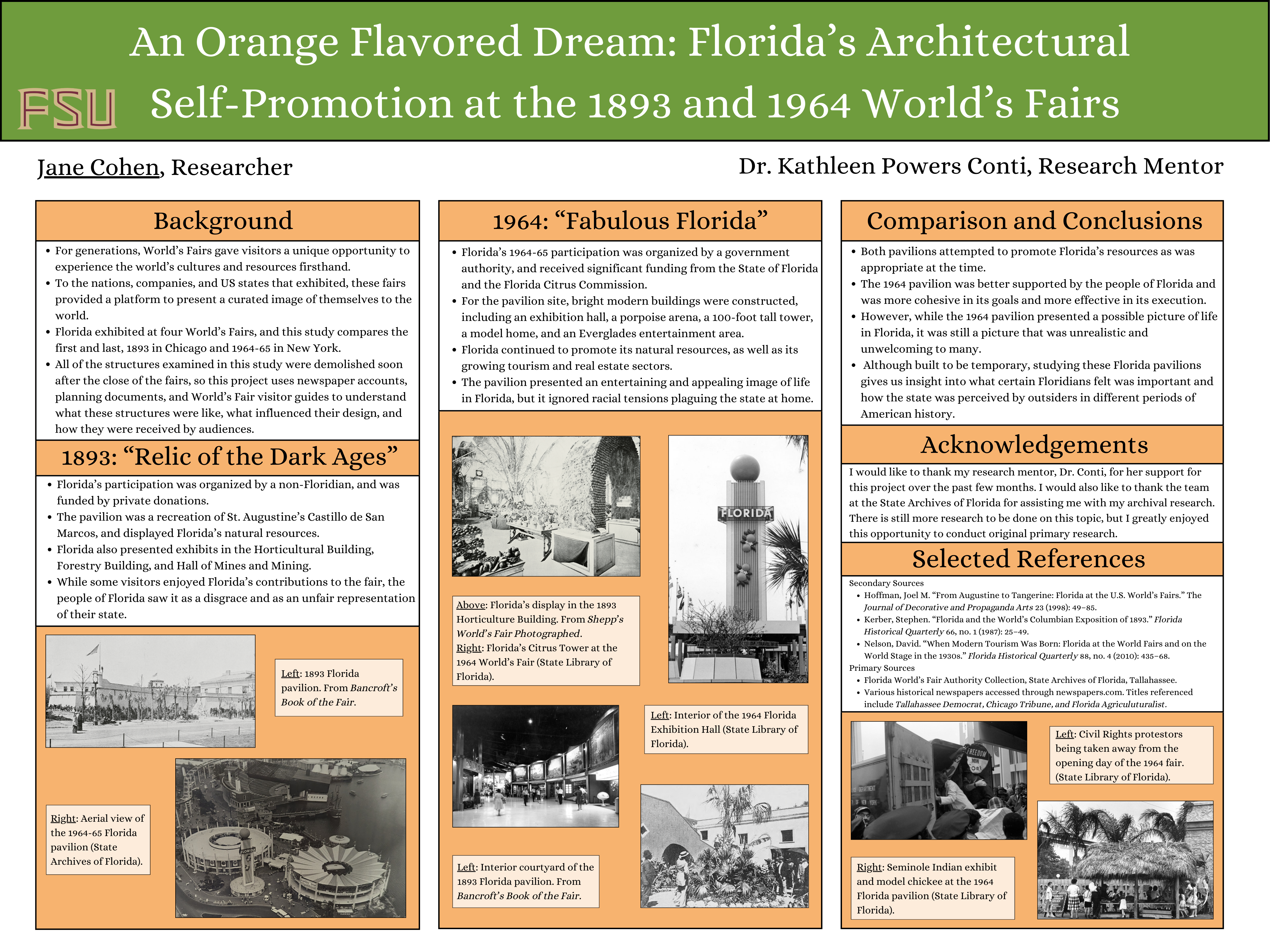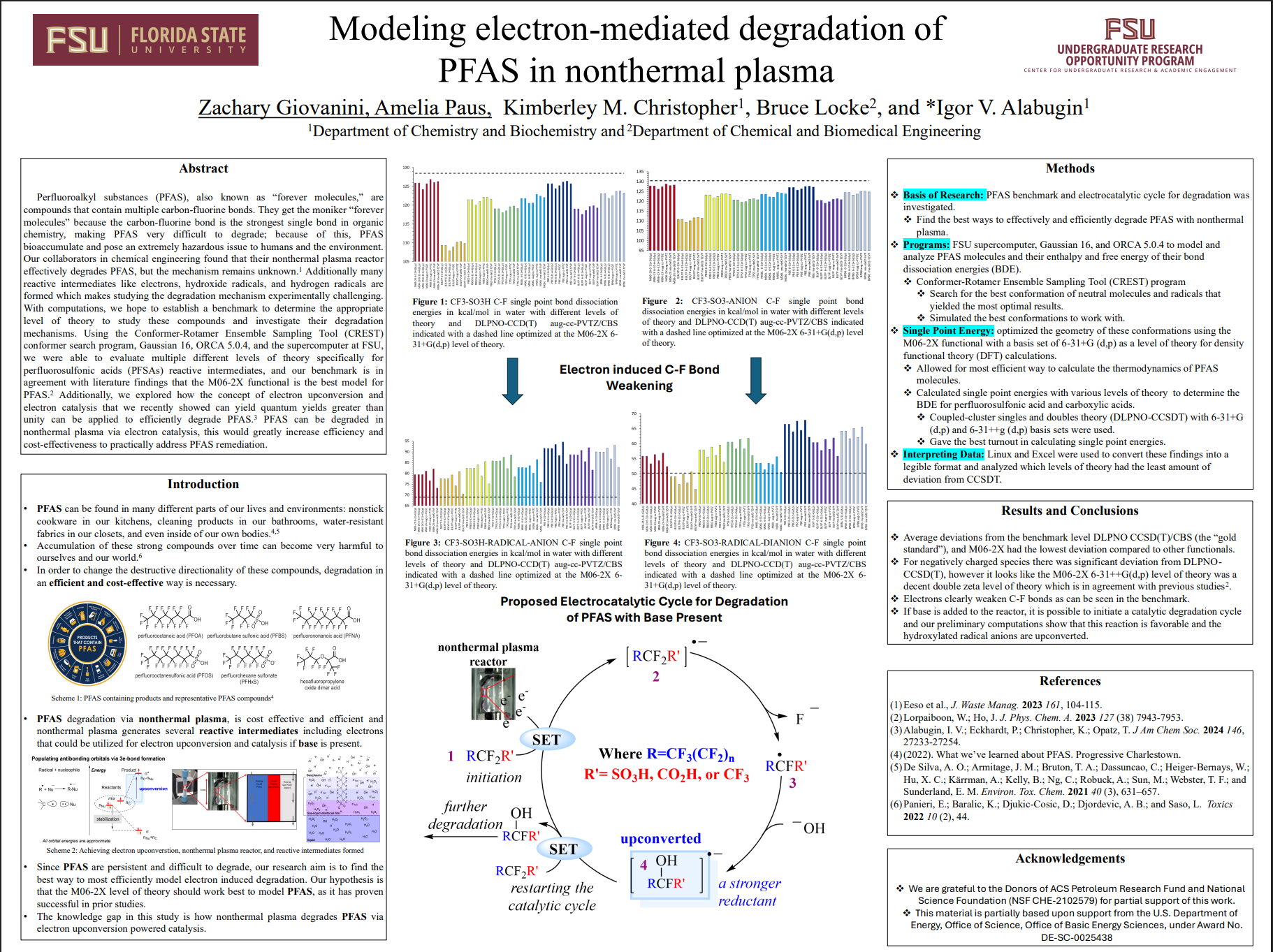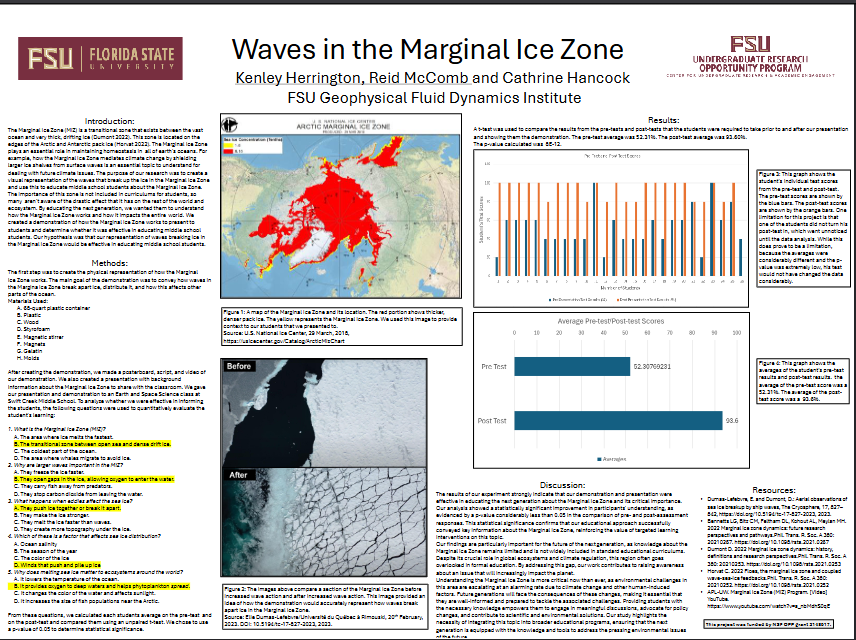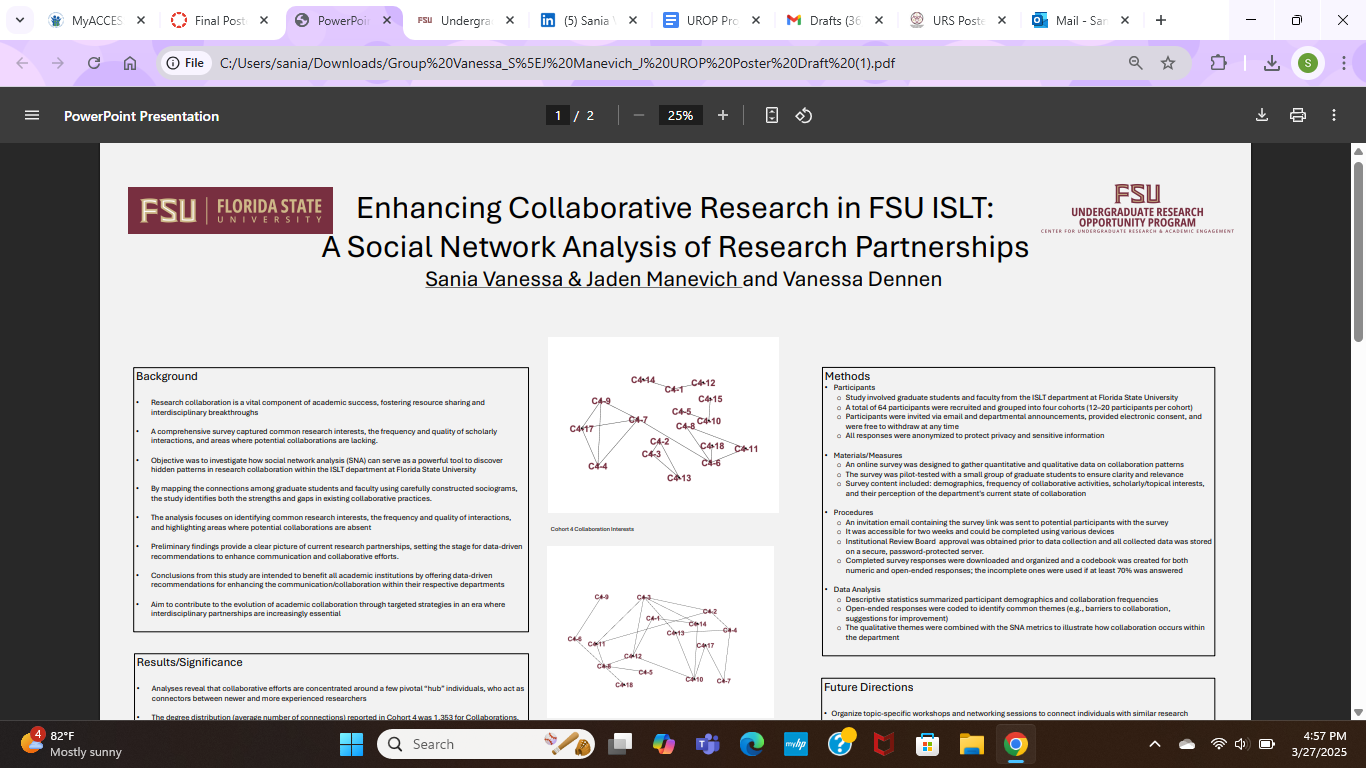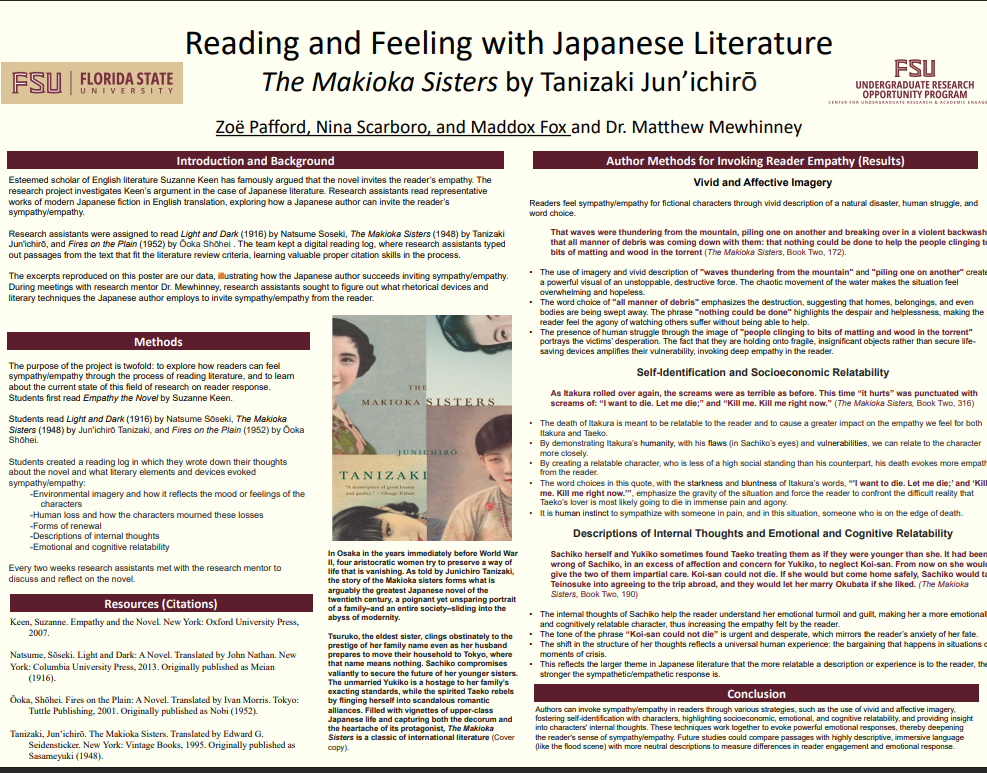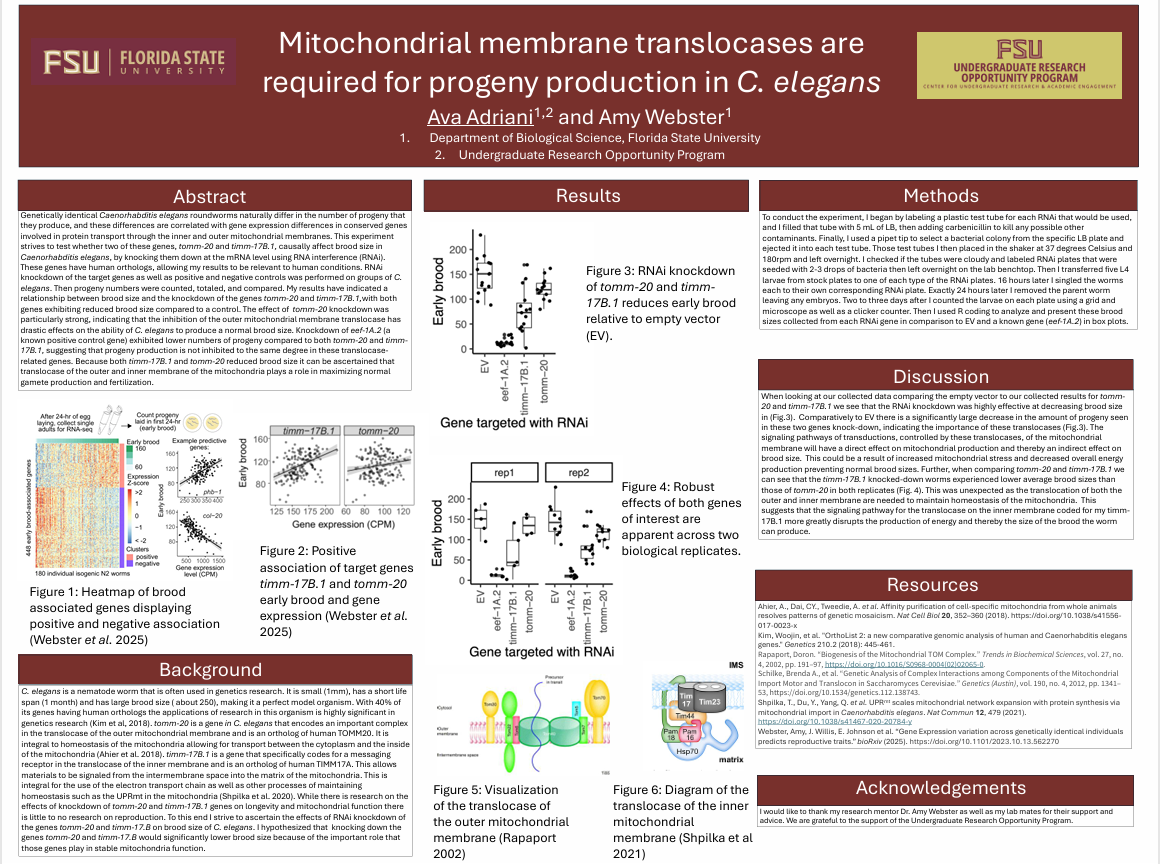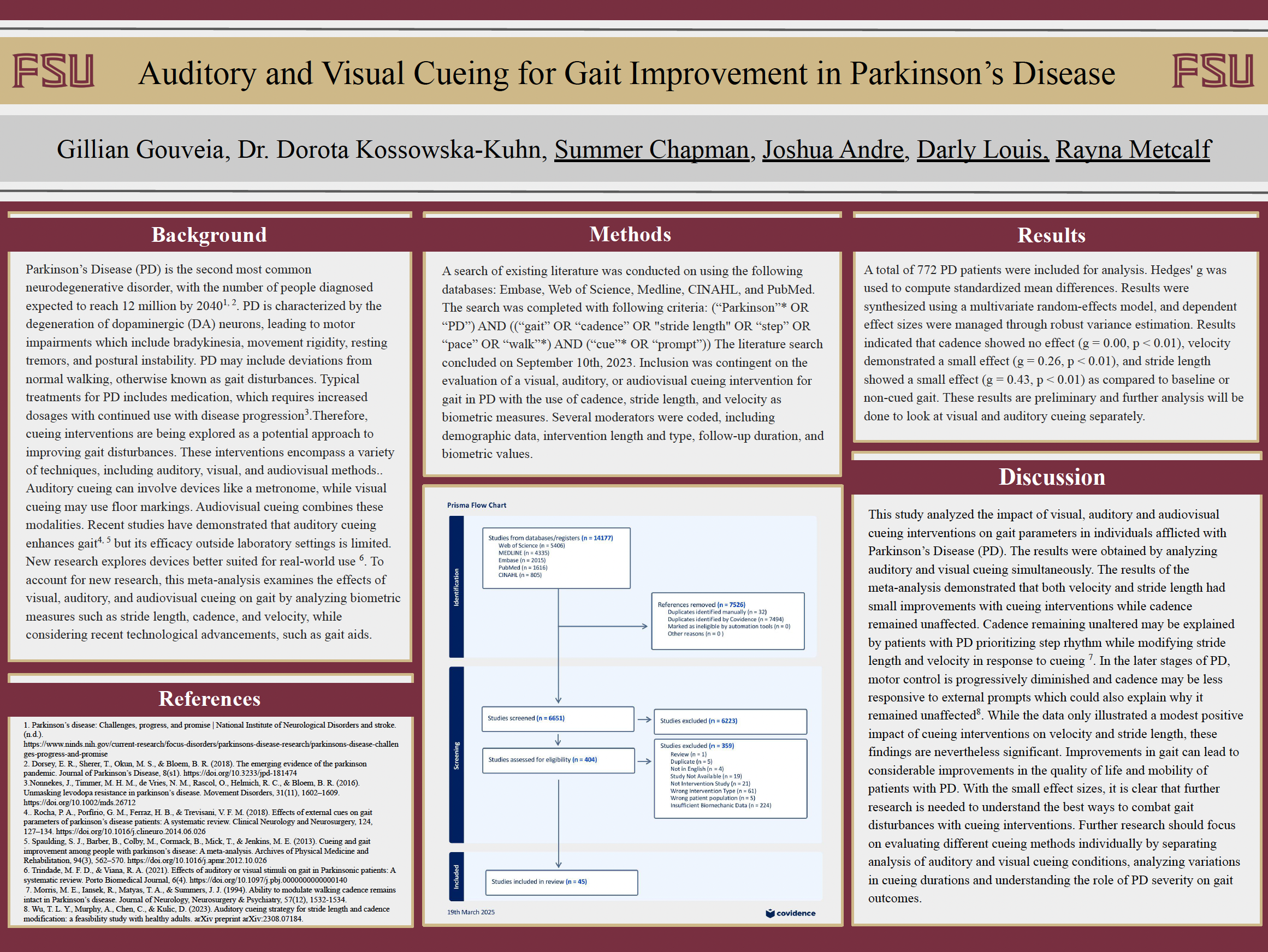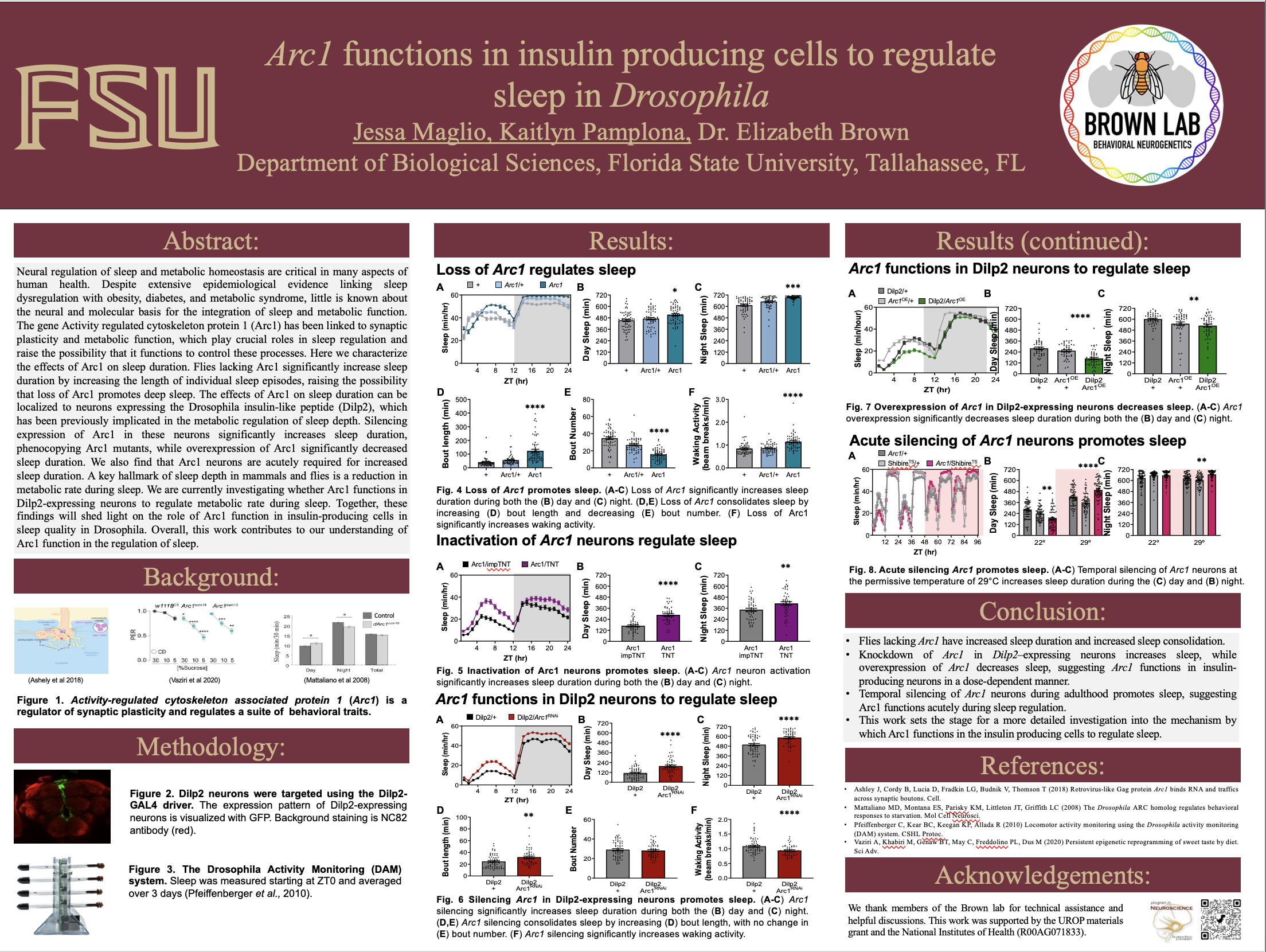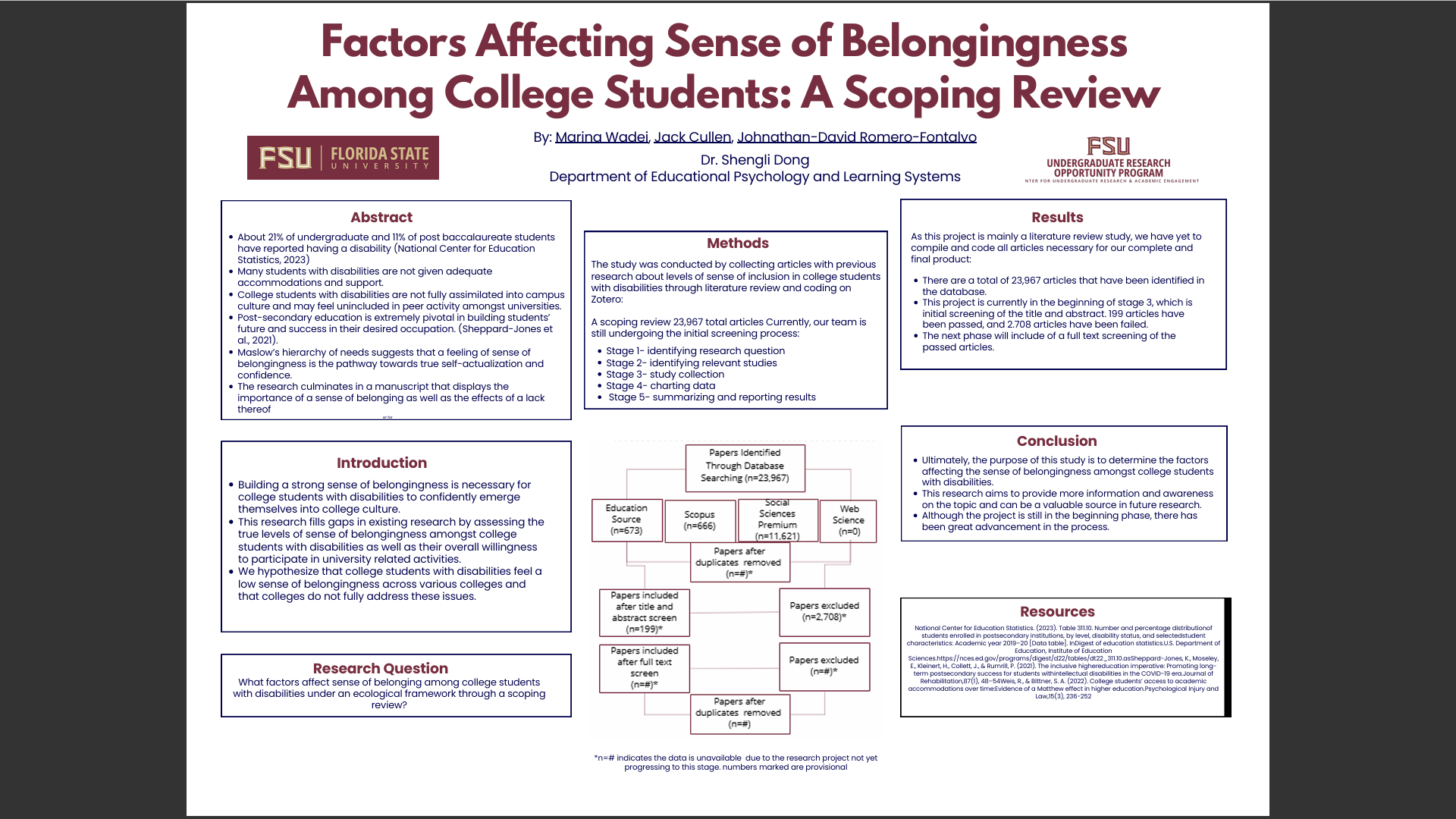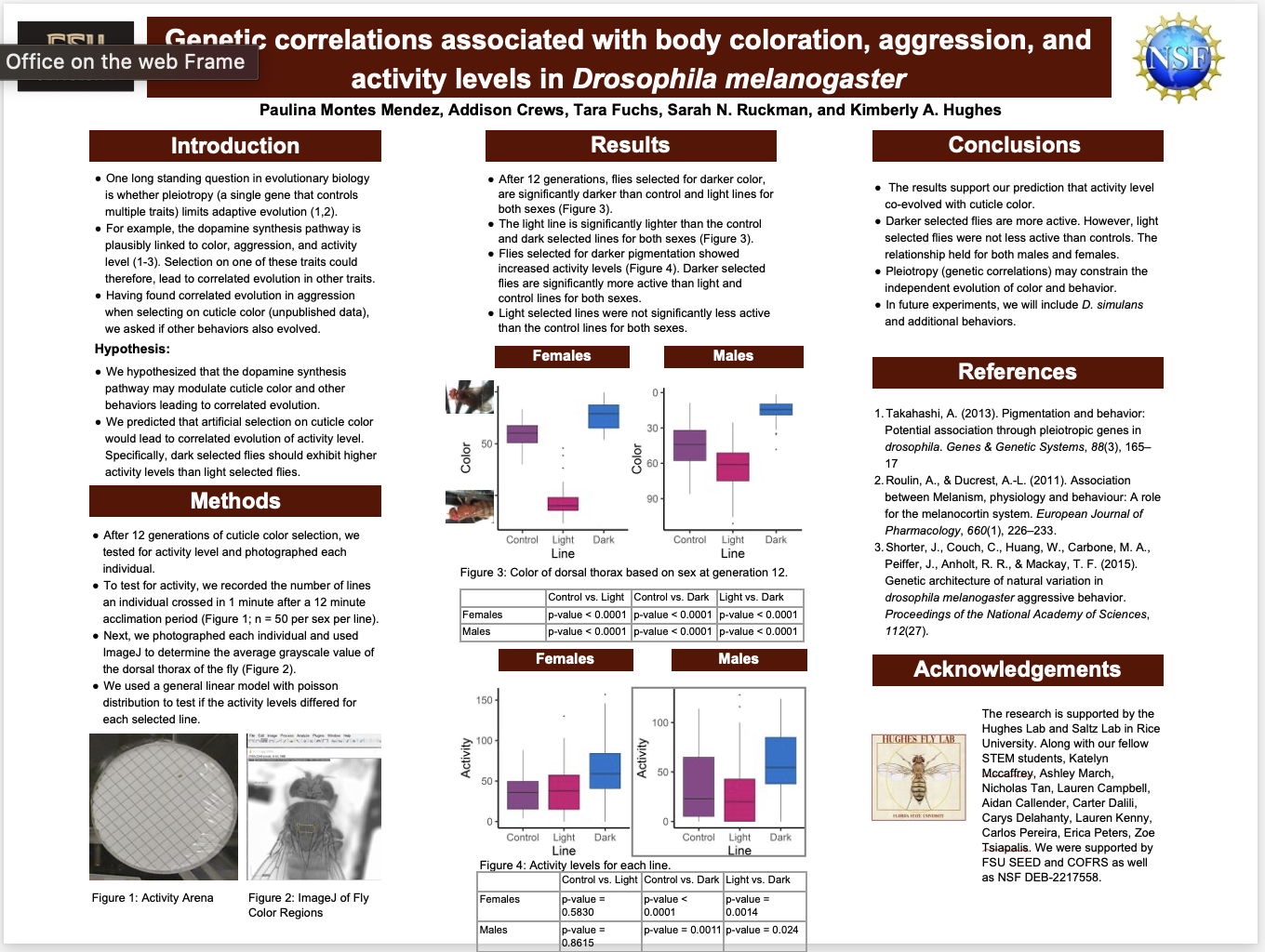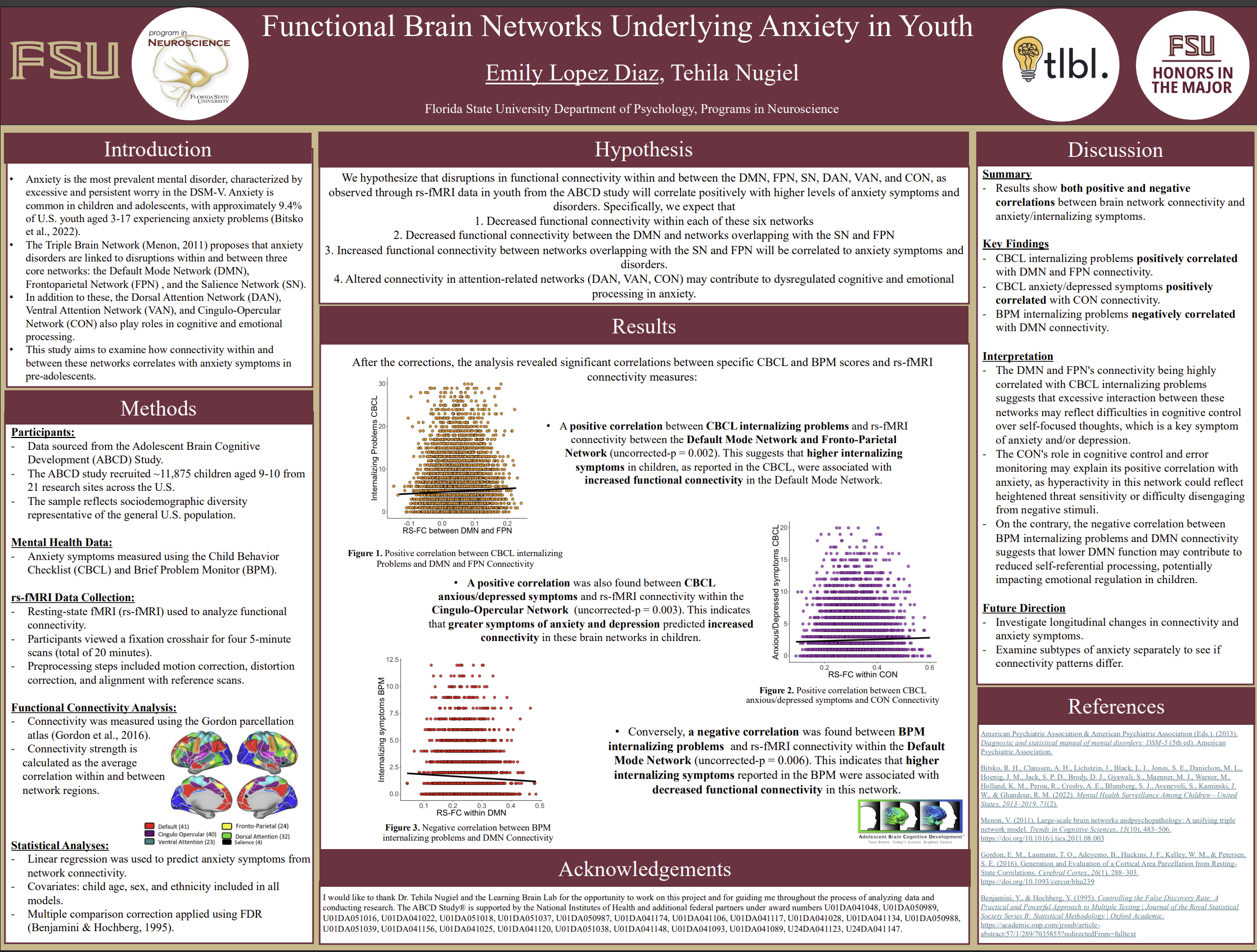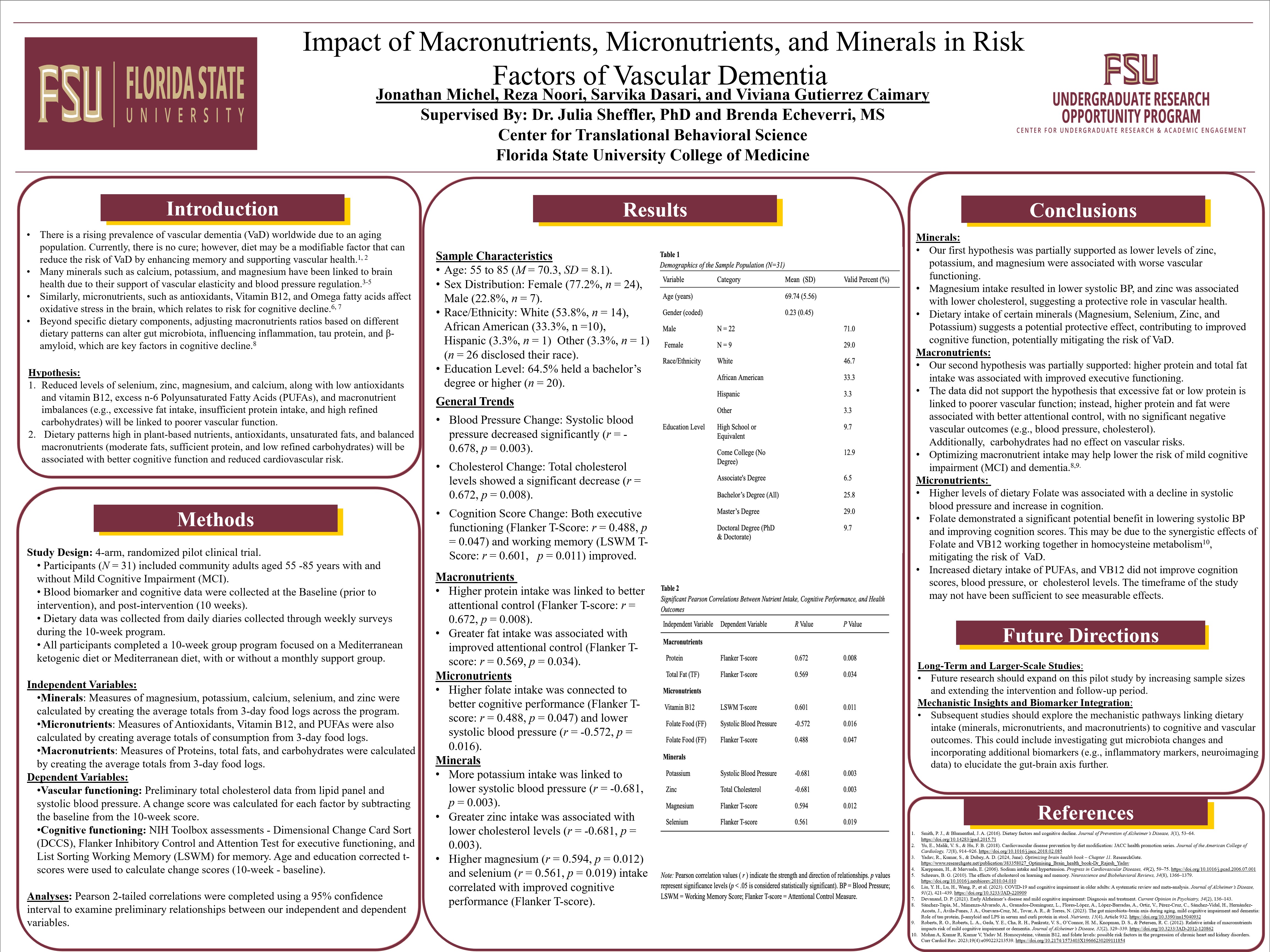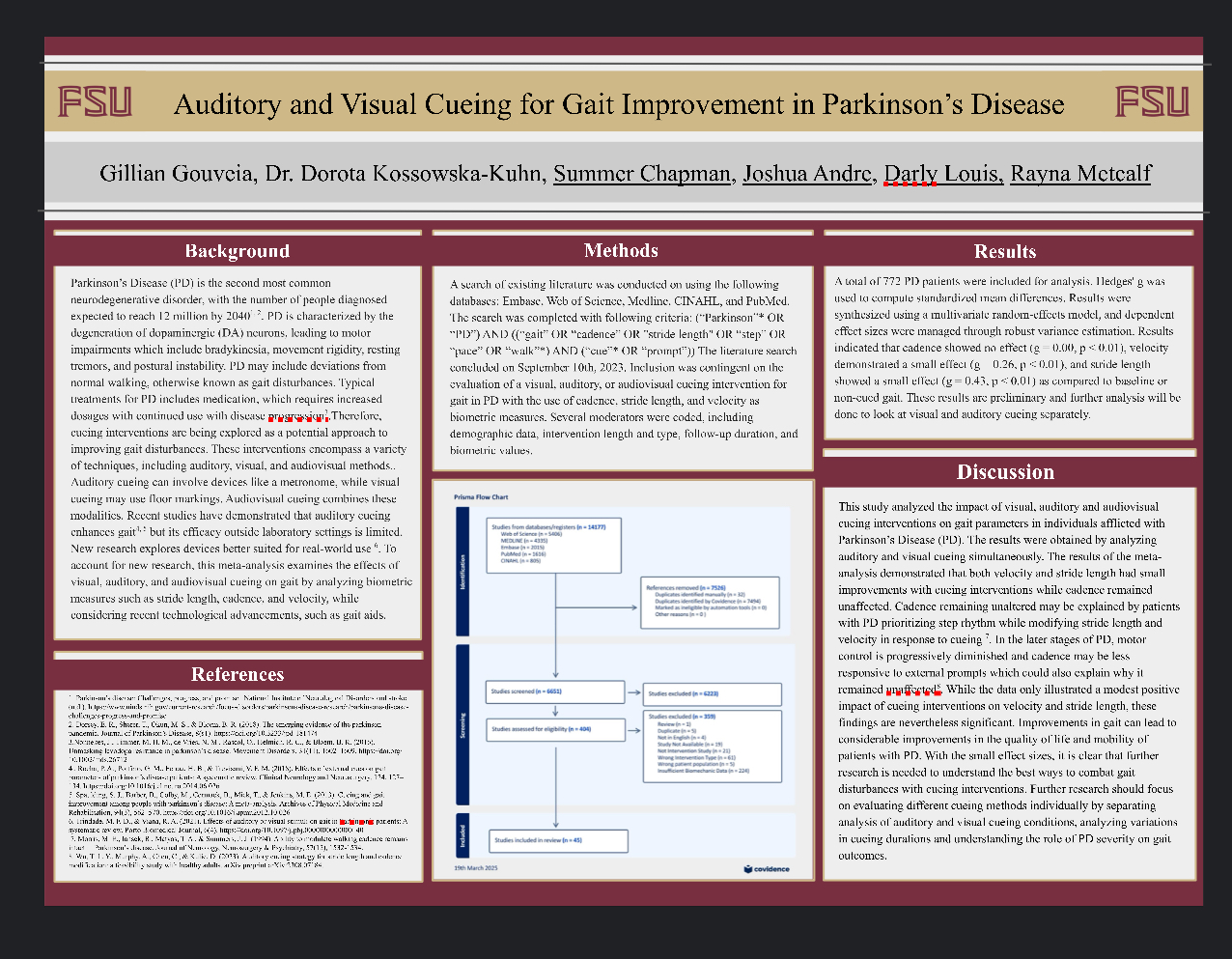Research Symposium
25th annual Undergraduate Research Symposium, April 1, 2025
Harper Kaplan Poster Session 2: 10:45 am - 11:45 am/ Poster #167

BIO
I am a first year student from Westchester, New York studying Psychology and Political Science on a Pre-Law track. Outside of UROP, I am involved with the Women In Pre-Law Society, Special Olympics Club, Club Ice Hockey, and Kappa Alpha Theta sorority.
Disability Homicide Database
Authors: Harper Kaplan, Brendan LantzStudent Major: Psychology, Political Science
Mentor: Brendan Lantz
Mentor's Department: Criminology & Criminal Justice Mentor's College: College of Criminology & Criminal Justice Co-Presenters: Kenny Bevan, Malia Crew, Julia Lobodzinski, Chable Graddy, Kennedy Murphy
Abstract
Violence against individuals with disabilities is a significant social issue, with fatal incidents—specifically those committed by family members or caretakers—being of particular concern. Addressing this violence requires a comprehensive understanding of these incidents; however, detailed data on such cases is currently lacking. This research project aims to fill this gap by developing a database of known homicides of disabled individuals in the United States over several decades. Researchers compiled data using open source data collection techniques, including collecting data from media reports, police records, social media, and obituaries, coding cases based on variables such as age, location, race, gender, type of violence, criminal history, and warning signs. The goal was to reach data saturation, ensuring the most complete picture of each case. This dataset enables pattern analysis through data analytics and research reports, providing patterns that can inform strategies to protect individuals with disabilities. Key indicators, such as prior criminal history or past child protective services involvement, can help law enforcement identify and intervene in high-risk situations before violence occurs. In the next phase, this project will continue gathering data and refining its approach seeking out common themes to better understand and prevent violence against individuals with disabilities. Collaboration with policymakers and law enforcement will play a crucial role in strengthening protective measures and addressing systemic gaps. Through ongoing analysis and public awareness efforts, this research aims to drive meaningful change and build a safer, more just society for individuals with disabilities.
Keywords: disability, homicide, autism
25th annual Undergraduate Research Symposium, April 1, 2025
Jack Slonimski Poster Session 4: 3:00 pm - 4:00 pm / Poster #248
BIO
My name is Jack Slonimski. My research interests are in enzymology. I am from West Palm Beach, Florida. I plan on continuing my education after undergraduate.
Influence of Surface Morphology on Enzymatic Plastic Degradation
Authors: Jack Slonimski, Wen ZhuStudent Major: Biochemistry
Mentor: Wen Zhu
Mentor's Department: Chemistry and Biochemistry Mentor's College: Arts and Science Co-Presenters:
Abstract
Polyethylene terephthalate (PET) is a widely used thermoplastic polymer, commonly found in single-use packaging due to its high chemical stability and resistance to degradation.1 As a result, PET waste accumulates throughout the biosphere and significantly contributes to the global pollution crisis.2 Ideonella sakaiensis is a bacterium capable of hydrolyzing PET into small molecules via the enzyme polyethylene terephthalate hydrolase (PETase).3 Engineered variants, such as FAST-PETase, have been shown to degrade selected PET products, such as water bottles and food containers.4 While factors such as crystallinity and surface morphology are known to influence the enzymatic depolymerization of plastics,5 the specific impact of surface abrasion on FAST-PETase efficiency remains unclear. In this study, we produced high yields of recombinant FAST-PETase in E. coli and adapted a UV-vis spectroscopic assay to monitor product formation at 240 nm. We tested a range of PET substrates with varying surface morphologies. Our findings highlight the potential for further enhancing FAST-PETase activity to improve the degradation of diverse plastic products and address plastic waste accumulation.
Keywords: Biochemistry, enzymes, plastic, environment, biodegradation
25th annual Undergraduate Research Symposium, April 1, 2025
Nicholas Tan Poster Session 2: 10:45 am - 11:45 am/ Poster #225

BIO
I am a senior at Florida State University with a strong passion for pursuing a career in optometry. Currently, I work under Dr. Kimberly A. Hughes in the Department of Biological Sciences, contributing to research focused on mapping the dopamine pathway in Drosophila melanogaster. In addition to my research experience, I gain hands-on clinical exposure each summer as an Ophthalmic Technician and Medical Scribe at Eye Health America, where I refine my technical skills and deepen my understanding of ocular health. I have developed proficiency in manual and automatic refractions, utilizing NextGen EHR software, performing applanation tonometry, and operating optical coherence tomography (OCT) machines. These experiences have equipped me with both the technical expertise and practical insights essential for a successful career in optometry.
The Correlation Between Cuticle Coloration and Negative Geotaxis in Drosophila melanogaster
Authors: Nicholas Tan, Sarah RuckmanStudent Major: IMS- Clinical Professions
Mentor: Sarah Ruckman
Mentor's Department: Department of Biological Science Mentor's College: Florida State University Co-Presenters: Aidan Callender
Abstract
One long-standing question in evolutionary biology is whether single genes that control multiple traits (pleiotropy) result in limitations on adaptive evolution. If it does, then our ability to predict adaptation (e.g., in the face of changing environments) is compromised. We are using a much-discussed correlation between body coloration and aggressive behavior as a system to address this question. Having found the predicted genetic correlation between cuticle color and aggressive behavior in Drosophila melanogaster using artificial selection (unpublished data), we then asked if any other behaviors co-evolved under selection on cuticle color. For example, the dopamine synthesis pathway is plausibly related to color, aggression, and other behaviors, such as geotaxis. Negative geotaxis is the movement of individuals against gravity. This is a measure of general activity and motor development. The efficiency of geotaxis measures movement ability, with a slower rate of geotaxis associated with a loss of motor development and neurodegeneration. We therefore measured the geotaxis ability of flies (D. melanogaster) selected for darker and lighter cuticle color. To measure geotaxis, flies are placed in a vertically sealed tube and timed for how quickly they climb to a predetermined mark at 3 inches from the bottom of the tube. Results suggest that the time to climb to the top of the tube is faster in the dark-selected lines, suggesting that genetic correlations do constrain the independent evolution of cuticle color and behavior.
Keywords: Drosophila melanogaster, pleiotropy, geotaxis
25th annual Undergraduate Research Symposium, April 1, 2025
Jane Cohen Poster Session 1: 9:30 am - 10:30 am/ Poster #122

BIO
Jane Cohen is a third year student at FSU, double majoring in music and history. A Tallahassee native, she is interested in learning about the past through historical newspapers and magazines, specifically focusing on nineteenth/early twentieth century popular culture. After graduation, she hopes to work in some sort of research, archival, or educational capacity.
An Orange Flavored Dream: Florida’s Architectural Self-Promotion at the 1893 and 1964 World’s Fairs
Authors: Jane Cohen, Kathleen Powers ContiStudent Major: Music and History
Mentor: Kathleen Powers Conti
Mentor's Department: History Mentor's College: Arts and Sciences Co-Presenters:
Abstract
For generations, World’s Fairs gave visitors a unique opportunity to experience the world’s cultures and resources firsthand. To the nations, companies, and US states that exhibited, these fairs provided a platform to present a curated image of themselves to the world. This project compares the first and last of Florida's four dedicated World's Fair pavilions, at the 1893 fair in Chicago and the 1964 fair in New York. The 1893 pavilion copied St. Augustine’s Castillo de San Marcos and featured displays on Florida agriculture and industry. Meanwhile, the 1964 pavilion was big, modern, and brightly colored, and under the slogan “Fabulous Florida,” emphasized the state’s potential for paradisiacal living.
All of the structures examined in this study were demolished soon after the close of the fairs, so this project uses newspaper accounts, planning documents, and World’s Fair visitor guides to understand what these structures were like, what influenced their design, and how they were received by audiences. The study finds that the both pavilions attempted to accomplish similar goals of promoting Florida’s economic potential, but the 1964 pavilion was better planned and offered a much more cohesive and authentic vision. However, while the 1964 pavilion was more effective, it still presented an image of Florida that was unrealistic and unwelcoming to many. Although built to be temporary, studying these Florida pavilions gives us insight into what Floridians felt was important and how the state was perceived by outsiders in different periods of American history.
Keywords: History, architecture, Florida, archives
25th annual Undergraduate Research Symposium, April 1, 2025
Alexa Athanassie Poster Session 1: 9:30 am - 10:30 am/ Poster #238
BIO
Hi! My name is Alexa Athanassie, and I'm from Tarpon Springs, FL. I am currently at junior at FSU with a major in Marketing and a minor in Psychology. I have been researching Misdemeanor Justice in the Second Circuit of Tallahassee for the last few months. I have conducted several courtroom observations, research collecting, and data analysis.
Misdemeanor (In)Justice
Authors: Alexa Athanassie, Maria Diaz MizeStudent Major: Marketing, Psychology
Mentor: Maria Diaz Mize
Mentor's Department: College of Criminology and Criminal Justice Mentor's College: Florida State University Co-Presenters: Vicki Baran, Hannah Gibb, Rachel Douglas, Phoenix Ricketts, Emily Fleurinor
Abstract
It is estimated that over 13 million misdemeanor cases are filed in the United States each year. Recent research has highlighted some of the concerns related to the misdemeanor system of justice in the United States, including violations of due process and practices that contribute to inequities. The current research intends to explore the misdemeanor system in Florida's Second Judicial Circuit to understand the extent to which misdemeanor courtrooms are complying with the law and to understand some of the factors associated with non-compliance and other potential sources of unfairness. To accomplish this, a team of undergraduate student researchers conducted systematic courtroom observations using a custom form across the circuit, comprised of six separate courtrooms. Observations included misdemeanor court arraignments and criminal traffic proceedings. Courtroom observations were completed in both rural and urban settings. Drawing on the data elicited during courtroom observations, future analyses will systematically explore local courtroom practices to capture the extent of legal compliance and to identify factors associated with non-compliance in legal proceedings. Our findings will be shared with local stakeholders to inform discussions of the misdemeanor system of justice, including ways to promote best practices.
Keywords: Criminology, Criminal Justice, Misdemeanor
25th annual Undergraduate Research Symposium, April 1, 2025
Amelia Paus Poster Session 3: 1:45 pm - 2:45 pm/ Poster #29

BIO
Born and raised in New Port Richey, Florida. I have always been fascinated by the environment. My research interest lies in public health, where I explore the impact of the environment on public health situations. Currently, I am a freshman, working on my bachelors in Public Health with a minor in Environmental Science and Policy. I aspire to be a change for the world, aiming to collect and analyze data to investigate health issues. I am particularly interested in genetics and diseases, and my long-term goal is to be an epidemiologist. In addition to my academic pursuits, I enjoy cheerleading, which helps balance my research-driven life.
Modeling electron-mediated degradation of PFAS in nonthermal plasma
Authors: Amelia Paus, Kimberley M. ChristopherStudent Major: Public Health
Mentor: Kimberley M. Christopher
Mentor's Department: Department of Chemistry and Biochemistry Mentor's College: Florida State University Co-Presenters: Zachary Giovanini
Abstract
Perfluoroalkyl substances (PFAS), also known as “forever molecules,” are compounds that contain multiple carbon-fluorine bonds. They get the moniker “forever molecules” because the carbon-fluorine bond is the strongest single bond in organic chemistry, making PFAS very difficult to degrade; because of this, PFAS bioaccumulate and pose an extremely hazardous issue to humans and the environment. Our collaborators in chemical engineering found that their nonthermal plasma reactor effectively degrades PFAS, but the mechanism remains unknown. Additionally many reactive intermediates like electrons, hydroxide radicals, and hydrogen radicals are formed which makes studying the degradation mechanism experimentally challenging. With computations, we hope to establish a benchmark to determine the appropriate level of theory to study these compounds and investigate their degradation mechanisms. Using the Conformer-Rotamer Ensemble Sampling Tool (CREST) conformer search program, Gaussian 16, ORCA 5.0.4, and the supercomputer at FSU, we were able to evaluate multiple different levels of theory specifically for perfluorosulfonic acids (PFSAs) reactive intermediates, and our benchmark is in agreement with literature findings that the M06-2X functional is the best model for PFAS. Additionally, we explored how the concept of electron upconversion and electron catalysis that we recently showed can yield quantum yields greater than unity can be applied to efficiently degrade PFAS. PFAS can be degraded in nonthermal plasma via electron catalysis, this would greatly increase efficiency and cost-effectiveness to practically address PFAS remediation.
Keywords: Perfluoroalkyl substances (PFAS), Carbon-Fluorine bonds, Gaussian 16, organic chemistry, chemical engineering
25th annual Undergraduate Research Symposium, April 1, 2025
Reid Mccomb Poster Session 1: 9:30 am - 10:30 am/ Poster #218
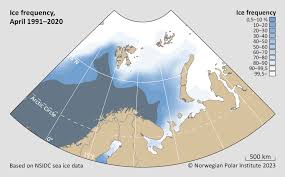
BIO
My name is Reid Mccomb. I am from Daytona Beach, Florida and have grown up with a passion for being in and around the ocean. I chose to study environmental science for this exact reason with the intent to pursue a career in the research of marine life in coastal areas.
Waves in the Marginal Ice Zone
Authors: Reid Mccomb, Cathrine HancockStudent Major: Environmental Science
Mentor: Cathrine Hancock
Mentor's Department: Geophysical Fluid Dynamics Institute Mentor's College: Florida State University Co-Presenters: Kenley Herrington
Abstract
The purpose of our research was to create a physical representation of how waves in the Marginal Ice Zone break up sea ice and then present this demonstration to students between 6th and 8th grade. We investigated this to determine how effective our demonstration was at educating students about the Marginal Ice Zone. This project is relevant to everyone in our community because it is of high importance that people begin to understand and spread knowledge of what goes on in our oceans. Through examining the ice in the Arctic Ocean, we can see how drastic changes affect the entire world. By educating the youth, we aim to spread a clear and impactful message to those around us of these issues. Our methods were to create a physical demonstration that the students could see to visualize how the Marginal Ice Zone works. We used various objects and tools such as wood, a plastic container, a magnetic stirrer, magnets, gelatin, Styrofoam, and molds. From presenting our demonstration to middle school students and testing their knowledge with a pre-test and post-test, we found that our demonstration did increase their understanding of the Marginal Ice Zone. We used a t-test to analyze our data and found that our results were statistically significant. With our data being statistically significant, we can conclude that presenting the topic with a hands-on demonstration was effective in the students' understanding of the project.
Keywords: Sea-Ice, Waves, Arctic
25th annual Undergraduate Research Symposium, April 1, 2025
Daniel Penzenstadler Poster Session 2: 10:45 am - 11:45 am/ Poster #91

BIO
My name is Daniel Penzenstadler and I'm a first year student from Denver Colorado on the Pre Med Track. I love to golf and ski and try to be outdoors as much as possible.
Reading and Feeling with Japanese Literature
Authors: Daniel Penzenstadler, Matthew MewhinneyStudent Major: Pre Biological Sciences
Mentor: Matthew Mewhinney
Mentor's Department: Modern Languages and Linguistics Mentor's College: University of California, Santa Barbara Co-Presenters: Daniel Lang
Abstract
How do authors use literary techniques to convey sympathy and empathy within the reader? It's important to understand the value and impact that texts can have on one’s emotions and analyzing how you get certain emotions from certain bodies of texts is crucial in that. This is super relevant to readers and the audience because if they can understand this and look for it when they read or even are just having a conversation, then we can all become more self aware and emotionally mature and understand how what is said can be perceived. I have read multiple novels and looked for Jamesian precision and other literary devices and tried to analyze what emotions they invoke. I did this with multiple other people and we all collaborated on our ideas. No real framework was utilized in this process; it wasn't cookie cutter at all and was very subjective. We found that Jamesian precision and various literary techniques all got different results and levels of sympathy and empathy. It's far too much to put in this, very subjective though. They don't suggest a whole lot other than that literature can have serious implications on psychology and emotions. The implications are just that you can guarantee that good writing can have a serious emotional impact on the reader when done correctly.
Keywords: Sympathy Reading Feelings Literature Japanese
25th annual Undergraduate Research Symposium, April 1, 2025
Sania Nixon Poster Session 4: 3:00 pm - 4:00 pm/ Poster #193

BIO
I am a 2nd-year psychology major at Florida State University on the pre-law track. I am passionate about serving as an advocate for those who are disadvantaged and underserved. I plan to pursue a master's in social work and advance to law school. My ultimate goal is to advocate for those who are experiencing hardship related to human rights.
Enhancing Collaborative Research in FSU ISLT: A Social Network Analysis of Research Partnerships
Authors: Sania Nixon, Vanessa DennenStudent Major: Psychology
Mentor: Vanessa Dennen
Mentor's Department: Edu Psychology & Learning Sys Mentor's College: Education Co-Presenters: Jaiden Manevich
Abstract
This study examines the transfer of knowledge in an academic setting, particularly emphasizing the interactions between professors, doctoral candidates, and undergraduate students at Florida State University and in Tallahassee. Through social network analysis, it reveals links and patterns between people and ideas, providing insights that conventional cohort-based studies could overlook. This method seeks to provide a more thorough comprehension of the flow and exchange of knowledge within the academic community.
The results of this study will illuminate how researchers, instructors, and students engage and communicate at various academic levels. By identifying important people and the channels by which ideas are exchanged, social network analysis makes it feasible to identify the unseen processes influencing scholarly activity.
Understanding these relationships may benefit educational institutions The findings may help develop regulations that encourage better teamwork, information exchange, and university academic networks. This study is important because it emphasizes the importance of examining knowledge exchange outside of conventional frameworks and provides fresh approaches to helping teachers and students.
In the end, this study advances a more comprehensive understanding of academic settings by highlighting the interdependence of people and ideas in advancing knowledge. The project's mapping of these networks aids in determining methods to enhance cooperation and communication, which benefits the academic community as well as the educational process as a whole.
Keywords: Social Network Analysis
25th annual Undergraduate Research Symposium, April 1, 2025
Maddox Fox Poster Session 4: 3:00 pm - 4:00 pm/ Poster #221

BIO
My name is Maddox Fox and I am a freshman pursuing a finance degree at Florida State University. I was born and raised in Jacksonville, Florida, and I have played baseball my whole life. I am unsure of the exact career direction I would like to take but I know that I want to be my own boss, however that may happen.
Reading and Feeling with Japanese Literature: The Makioka Sisters by Tanizaki Jun’ichirō
Authors: Maddox Fox, Matthew MewhinneyStudent Major: Finance
Mentor: Matthew Mewhinney
Mentor's Department: Modern Languages and Linguistics Mentor's College: College of Arts and Sciences Co-Presenters:
Abstract
This research seeks to determine what language devices, plot developments, descriptions of nature, and other literary devices influence the reader’s empathy to shape their experience of reading Japanese literature. The research presented is a part of Dr. Matthew Mewhinney’s larger book project on reading and feeling in Japanese literature. The methodologies used in this project align with the practice of close reading, as careful attention was directed to the actual experience of reading while using annotation to record thoughts about the text as they occurred. The framework utilized to record the data was a reading log. This reading log served to isolate specific passages from the readings that invoked empathy in the reader, along with an explanation of the technique that the author used to accomplish this. The main results of the methodology point to the influence of narration technique, characterization, dialogue, irony, and plot development as the main contributors to an empathetic response in the reader. These findings are important because they underline the most effective methods of invoking emotional responses in the reader. Some potential future developments in the research would be to read the novels in Japanese as opposed to their English translation to determine whether the empathetic passages remain the same in either language. This knowledge could help writers around the world put more emotion into their writing. This research contributes to the field of Japanese literature because it outlines the most effective techniques to invoke empathetic responses in the reader.
Keywords: Japanese, language, reading, empathy, sympathy
25th annual Undergraduate Research Symposium, April 1, 2025
Ava Adriani Poster Session 1: 9:30 am - 10:30 am/ Poster #14

BIO
I am a first-year student majoring in Biology here at Florida State University. I am honored to be a member of FSU’s Honors Program and Presidential Scholars Program. My passions include genetics, immunology, and microbiology. In pursuing this, I proved the necessity of mitochondrial membrane translocases in the progeny production of Caenorhabditis elegans with the guidance of Dr. Webster through this research. After graduation, I envision having a career in biological research or computation, adding to the world's knowledge through experimentation and data analysis.
Mitochondrial membrane translocases are required for progeny production in C. elegans
Authors: Ava Adriani, Dr Amy WebsterStudent Major: Biology
Mentor: Dr Amy Webster
Mentor's Department: Department of Biological Science Mentor's College: Biology Co-Presenters:
Abstract
Genetically identical Caenorhabditis elegans roundworms naturally differ in the number of progeny that they produce, and these differences are correlated with gene expression differences in conserved genes involved in protein transport through the inner and outer mitochondrial membranes. This experiment strives to test whether two of these genes, tomm-20 and timm-17B.1, causally affect brood size in Caenorhabditis elegans, by knocking them down at the mRNA level using RNA interference (RNAi). These genes have human orthologs, allowing my results to be relevant to human conditions. RNAi knockdown of the target genes as well as positive and negative controls was performed on groups of C. elegans. Then progeny numbers were counted, totaled, and compared. My results have indicated a relationship between brood size and the knockdown of the genes tomm-20 and timm-17B.1,with both genes exhibiting reduced brood size compared to a control. The effect of tomm-20 knockdown was particularly strong, indicating that the inhibition of the outer mitochondrial membrane translocase has drastic effects on the ability of C. elegans to produce a normal brood size. Knockdown of eef-1A.2 (a known positive control gene) exhibited lower numbers of progeny compared to both tomm-20 and timm-17B.1, suggesting that progeny production is not inhibited to the same degree in these translocase related genes. Because both timm-17B.1 and tomm-20 reduced brood size it can be ascertained that translocase of the outer and inner membrane of the mitochondria plays a role in maximizing normal gamete production and fertilization.
Keywords: C. elegans Mitochondrial Membrane Translocases
25th annual Undergraduate Research Symposium, April 1, 2025
Joshua Andre Poster Session 1: 9:30 am - 10:30 am / Poster #267
BIO
My name is Joshua Andre and I am a junior pre-med student majoring in exercise physiology with a strong passion for medicine and human performance. I work at Patients First Urgent Care, where I gain hands-on experience in patient care and medical procedures. In addition to my clinical work, I conduct research on Parkinson’s disease, contributing to a better understanding of neurodegenerative disorders. My experiences in both research and patient care have reinforced my desire to pursue medicine and make a meaningful impact in the field.
Auditory and Visual Cueing for Gait Improvement in Parkinson’s Disease
Authors: Joshua Andre, Gillian GouveiaStudent Major: Exercise Physiology
Mentor: Gillian Gouveia
Mentor's Department: Psychology Mentor's College: FSU College of Arts and Sciences Co-Presenters: Summer Chapman, Darly Louis, Rayna Metcalf
Abstract
Parkinson’s Disease (PD) is a neurodegenerative disorder marked by the degeneration of dopaminergic (DA) neurons in the substantia nigra pars compacta (SNc), a key region housing the majority of dopamine-producing neurons. This degeneration results in dopamine depletion and subsequent motor impairments. Thus, PD commonly presents with motor symptoms such as bradykinesia, rigidity, and resting tremors that affect movements such as walking, otherwise known as gait. Prior research suggests that visual and auditory cueing can improve gait disturbances. This meta-analysis examines how different cueing methods impact gait by analyzing biometric values such as stride length, cadence, and velocity. A search of existing literature was conducted using Embase, Web of Science, Medline, CINAHI, and PubMed. Studies included visual, auditory, or audiovisual cueing interventions for PD patients. Several moderators were coded, including demographic data, intervention length, follow-up duration, and biometric changes. A total of 772 PD patients were included for analysis. Results indicated that cadence showed no effect (g = 0.00, p < 0.01), velocity demonstrated a small effect (g = 0.26, p < 0.01), and stride length showed a small effect (g = 0.43, p < 0.01) as compared to baseline or non-cued gait. For the purpose of analysis, auditory and visual cueing were combined. Data synthesis was conducted using a multivariate random-effects model, and dependent effect sizes were addressed through robust variance estimation. Further moderator analysis is needed to explore the relationship between intervention types and biometric value changes.
Keywords: Parkinsons, Gait, PD
25th annual Undergraduate Research Symposium, April 1, 2025
Kaitlyn Pamplona Poster Session 1: 9:30 am - 10:30 am / Poster #161

BIO
I am a senior majoring in Biological Sciences. I am from Tampa, FL. I started in the Brown Behavioral Neurogenetics Lab in Summer 2024.
Arc1 functions in insulin producing cells to regulate sleep in Drosophila
Authors: Kaitlyn Pamplona, Elizabeth BrownStudent Major: Biological Sciences
Mentor: Elizabeth Brown
Mentor's Department: Department of Biological Science Mentor's College: FSU College of Arts and Sciences Co-Presenters: Jessa Maglio
Abstract
Neural regulation of sleep and metabolic homeostasis are critical in many aspects of human health. Despite extensive epidemiological evidence linking sleep dysregulation with obesity, diabetes, and metabolic syndrome, little is known about the neural and molecular basis for the integration of sleep and metabolic function. The gene Activity regulated cytoskeleton protein 1 (Arc1) has been linked to synaptic plasticity and metabolic function, which play crucial roles in sleep regulation and raise the possibility that it functions to control these processes. Here we characterize the effects of Arc1 on sleep duration. Flies lacking Arc1 significantly increase sleep duration by increasing the length of individual sleep episodes, raising the possibility that loss of Arc1 promotes deep sleep. The effects of Arc1 on sleep duration can be localized to neurons expressing the Drosophila insulin-like peptide (Dilp2), which has been previously implicated in the metabolic regulation of sleep depth. Silencing expression of Arc1 in these neurons significantly increases sleep duration, phenocopying Arc1 mutants, while overexpression of Arc1 significantly decreased sleep duration. We also find that Arc1 neurons are acutely required for increased sleep duration. A key hallmark of sleep depth in mammals and flies is a reduction in metabolic rate during sleep. We are currently investigating whether Arc1 functions in Dilp2-expressing neurons to regulate metabolic rate during sleep. Together, these findings will shed light on the role of Arc1 function in insulin-producing cells in sleep quality in Drosophila. Overall, this work contributes to our understanding of Arc1 function in the regulation of sleep.
Keywords: drosophila, sleep, protein
25th annual Undergraduate Research Symposium, April 1, 2025
Marina Wadei Poster Session 1: 9:30 am - 10:30 am / Poster #125

BIO
My name is Marina Wadei and I am a sophomore majoring in Behavioral Neuroscience. I'm from Jacksonville and I enjoy traveling and nature. I am assisting Dr. Shengli Dong in his research on exploring sense of belongingness in students with disabilities in college.
Analyzing the Sense of Belongingness in College Students with Disabilities
Authors: Marina Wadei, Shengli DongStudent Major: Behavioral Neuroscience
Mentor: Shengli Dong
Mentor's Department: Educational Psychology and Learning Systems Mentor's College: Florida State University Co-Presenters: Jack Cullen and Johnathan-David Romero-Fontalvo
Abstract
This research aims to examine the mental health and sense of belonging of college students with disabilities. We conduct a literature review, selecting articles that underscore the mental well-being and social integration of students with disabilities. The research culminates in a manuscript that displays the importance of a sense of belonging as well as the effects of a lack thereof. Throughout this manuscript, we integrate Maslow’s hierarchy of needs theory to reveal how a lack of a sense of belongingness can lead to increasing rates of depression, anxiety and extremely low self-esteem. Although no definitive conclusions have been reached yet, we hypothesize that many students with disabilities experienced feeling a low sense of belonging and purpose in college settings.
Keywords: student with disabilities
25th annual Undergraduate Research Symposium, April 1, 2025
Jonas Benjo Poster Session 1: 9:30 am - 10:30 am / Poster #280

BIO
Career goal: Pursue an MD-pHD program, to help people hands on as well as through research
fields of intrest: Pharmacology, molecular simulation, genetic therapies
Prion Misfolding: Beta-Sheet Destabilization
Authors: Jonas Benjo, Joshua MysonaStudent Major: Biomedical engineering (Cell and Bioprocess)
Mentor: Joshua Mysona
Mentor's Department: Department of Chemical and Biomedical Engineering Mentor's College: FAMU-FSU College of Engineering Co-Presenters: Zaid Abulaban
Abstract
Prion diseases are a group of fatal neurodegenerative disorders caused by the misfolding of the prion
protein (PrP). The misfolded form propagates by converting native PrP into its pathogenic
conformation, yet the precise molecular mechanisms underlying this process remain poorly
understood. A key step in misfolding involves structural destabilization, particularly in the β-sheet
regions of PrP. Molecular dynamics (MD) simulations provide atomic-level insights into protein
misfolding, but conventional approaches are hindered by the large disparity between biologically
relevant folding timescales and computational limitations. To overcome this barrier, we employ
advanced sampling techniques to investigate the unzipping of the β-sheet in properly folded PrP, a
potential early-stage event in misfolding. Our simulations capture conformational transitions that
reveal key intermediates and energy barriers associated with β-sheet destabilization. By characterizing
these molecular events, we provide novel insight into the earliest structural changes that may lead to
prion propagation. Understanding these misfolding pathways is essential for elucidating prion disease
mechanisms and could inform future therapeutic strategies aimed at stabilizing the native PrP
conformation, thereby preventing disease onset.
Keywords: Protein aggregation, Molecular Dynamics, Simulation
25th annual Undergraduate Research Symposium, April 1, 2025
Tara Fuchs Poster Session 3: 1:45 pm - 2:45 pm / Poster #17

BIO
I am a senior majoring in Biological Science and minoring in Environmental Science. I am also the current president of FSU's Biological Honor Society, Tri-Beta, and was a member of the Marching Chiefs for two years. My future goal is to attend graduate school and research STEM cell therapy.
Genetic correlations associated with body coloration, aggression, and activity levels in Drosophila melanogaster
Authors: Tara Fuchs, Sarah N. RuckmanStudent Major: Biological Science
Mentor: Sarah N. Ruckman
Mentor's Department: Ecology and Evolution Mentor's College: FSU Biological Science Co-Presenters: Addison Crews, Paulina Montes Mendez
Abstract
One long-standing question in evolutionary biology is whether single genes that control multiple traits (pleiotropy) result in limitations on adaptive evolution. If it does, then our ability to predict adaptation (e.g., in the face of changing environments) is compromised. We are using a much-discussed correlation between body coloration and aggressive behavior as a system to address this question. Having found the predicted
genetic correlation between cuticle color and aggressive behavior in Drosophila melanogaster using artificial selection (unpublished data), we then asked if any other behaviors co-evolved under selection on cuticle color. For example, the dopamine synthesis pathway is plausibly related to color, aggression, and other behaviors, such as activity level. We therefore measured the activity level of flies (D. melanogaster) selected for darker and lighter cuticle color. Results suggest that activity level is higher in the dark-selected lines, suggesting that genetic correlations do constrain the independent evolution of cuticle color and behavior. The next step in this study is to identify candidate genes underlying the correlation and test for pleiotropic effects using transgenic approaches.
Keywords: Plieitropy, Evolution
25th annual Undergraduate Research Symposium, April 1, 2025
Summer Chapman Poster Session 2: 10:45 am - 11:45 am/ Poster #267

BIO
My name is Summer Chapman, I am a senior in the IMS program, majoring in Clinical Professions. I am a pre-medical student planning to apply this cycle. I have been an active participant in research while interests primarily in neurological disorders.
Auditory and Visual Cueing for Gait Improvement in Parkinson’s Disease
Authors: Summer Chapman, Gillian GouveiaStudent Major: IMS: Clinical Professions
Mentor: Gillian Gouveia
Mentor's Department: Psychology Mentor's College: Arts and Sciences Co-Presenters: Summer Chapman, Joshua Andre, Darly Louis, Rayna Metcalf
Abstract
Parkinson’s Disease (PD) is a neurodegenerative disorder marked by the degeneration of dopaminergic (DA) neurons in the substantia nigra pars compacta (SNc), a key region housing the majority of dopamine-producing neurons. This degeneration results in dopamine depletion and subsequent motor impairments. Thus, PD commonly presents with motor symptoms such as bradykinesia, rigidity, and resting tremors that affect movements such as walking, otherwise known as gait. Prior research suggests that visual and auditory cueing can improve gait disturbances. This meta-analysis examines how different cueing methods impact gait by analyzing biometric values such as stride length, cadence, and velocity. A search of existing literature was conducted using Embase, Web of Science, Medline, CINAHI, and PubMed. Studies included visual, auditory, or audiovisual cueing interventions for PD patients. Several moderators were coded, including demographic data, intervention length, follow-up duration, and biometric changes. A total of 772 PD patients were included for analysis. Results indicated that cadence showed no effect (g = 0.00, p < 0.01), velocity demonstrated a small effect (g = 0.26, p < 0.01), and stride length showed a small effect (g = 0.43, p < 0.01) as compared to baseline or non-cued gait. For the purpose of analysis, auditory and visual cueing were combined. Data synthesis was conducted using a multivariate random-effects model, and dependent effect sizes were addressed through robust variance estimation. Further moderator analysis is needed to explore the relationship between intervention types and biometric value changes.
Keywords: Parkinson's, Neurological, Gait
25th annual Undergraduate Research Symposium, April 1, 2025
Emily Lopez Diaz Poster Session 4: 3:00 pm - 4:00 pm / Poster #232

BIO
I am a third year Cell and Molecular Neuroscience student that is currently in the Learning Brain Lab at Florida State University working on my Honors in the Major project. This research project has allowed me to learn how to analyze data and conduct research outside of a classroom while still being able to explore my interests in addressing the impact of mental health issues in youth. With future plans to go to medical school and become a pediatrician, this research project allowed me to advance my knowledge in holistic approaches within medicine. This will allow me to become an advocate for youth that are going through mental health crises within my role as a pediatrician while helping to reduce the stigma surrounding societal perceptions of psychological health.
Functional Brain Networks Underlying Anxiety in Youth
Authors: Emily Lopez Diaz, Dr. Tehila NugielStudent Major: Cell and Molecular Neuroscience
Mentor: Dr. Tehila Nugiel
Mentor's Department: Department of Psychology Mentor's College: College of Arts and Sciences Co-Presenters:
Abstract
Anxiety is a prevalent mental disorder that is characterized by excessive and persistent worry. This study investigates the relationship between functional connectivity and anxiety in pre-adolescent youth using a prominent theory of brain function underlying anxiety, the Triple Brain Network Model. Using data from the Adolescent Brain Cognitive Development (ABCD) Study, we will analyze six key brain networks: the Default Mode Network (DMN), Frontoparietal Network (FPN), Salience Network (SN), Dorsal Attention Network (DAN), Ventral Attention Network (VAN), and Cingulo-Opercular Network (CON) to examine how disruptions within and between the networks correlate with anxiety symptoms. We hypothesize that anxiety symptoms correlate with decreased connectivity within and between these networks, decreased connectivity between the DMN and networks overlapping the SN and FPN and increased connectivity between networks that overlap with the SN and FPN. Our findings aim to provide insights into how large scale brain networks are related to anxiety in pre-adolescent youth.
Keywords: Neuroscience, Youth, fMRI imaging, Anxiety
25th annual Undergraduate Research Symposium, April 1, 2025
Sarvika Dasari Poster Session 3: 1:45 pm - 2:45 pm / Poster #134

BIO
I am a fourth-year Behavioral Neuroscience student from St. Augustine, FL. My research explores the connections between nutrients and Alzheimer’s disease, focusing on how dietary factors influence cognitive health. I have a keen interest in the integrative prevention of lifestyle risk factors for cognitive impairment.
Impact of Macronutrients, Micronutrients, and Minerals in Risk Factors of Vascular Dementia
Authors: Sarvika Dasari, Dr. Julia ShefflerStudent Major: Behavioral Neuroscience
Mentor: Dr. Julia Sheffler
Mentor's Department: Department of Behavioral Sciences and Social Medicine in the College of Medicine Mentor's College: Southern Illinois University Co-Presenters: Reza Noori and Jonathan Michel
Abstract
Vascular dementia (VaD) is a growing global health concern, exacerbated by an aging population and its associated economic and social burdens. While there is no cure, prevention strategies targeting modifiable risk factors—particularly diet—have gained significant attention. Macronutrients, micronutrients, and minerals play crucial roles in cognitive function and vascular health, yet their specific mechanisms remain unclear. Dietary patterns such as the Mediterranean and ketogenic diets have shown the potential to reduce dementia risk by improving metabolic and cardiovascular health. This study examines the relationship between specific dietary components and VaD risk factors in high-risk older adults through a 10-week pilot clinical trial. Thirty-one participants (aged 55–85 years, MoCA ≥16) were randomized into four intervention groups: a Mediterranean diet or a Mediterranean ketogenic diet, with or without a support group. Assessments included dietary tracking (Nutritionix), blood biomarker analysis, gut microbiome composition, and cognitive testing using the NIH Toolbox Cognition Battery. Macronutrient ratios, antioxidants, omega fatty acids, and essential minerals (magnesium, potassium, calcium, selenium, zinc) were analyzed alongside vascular risks. This study aims to identify how specific dietary components are associated with change in executive functioning, blood pressure, and cholesterol across a 10-week dietary intervention. These findings will contribute to a broader understanding of dietary interventions for mitigating vascular dementia risk in aging populations.
Keywords: Vascular Dementia, Nutritional Adhere
25th annual Undergraduate Research Symposium, April 1, 2025
Rayna Metcalf Poster Session 3: 1:45 pm - 2:45 pm / Poster #267

BIO
Apart from participating in research, I am also a member of Seminole Dance Force and am a morale captain for Dance Marathon!
Auditory and Visual Cueing for Gait Improvement in Parkinson’s Disease
Authors: Rayna Metcalf, Gillian GouveiaStudent Major: cell and molecular neuroscience
Mentor: Gillian Gouveia
Mentor's Department: Psychology Mentor's College: College of arts and sciences Co-Presenters:
Abstract
Parkinson’s Disease (PD) is the second most common neurodegenerative disorder, with the number of people diagnosed expected to reach 12 million by 20401, 2. PD is characterized by the degeneration of dopaminergic (DA) neurons, leading to motor impairments which include bradykinesia, movement rigidity, resting tremors, and postural instability. PD may include deviations from normal walking, otherwise known as gait disturbances. Typical treatments for PD includes medication, which requires increased dosages with continued use with disease progression3.Therefore, cueing interventions are being explored as a potential approach to improving gait disturbances. These interventions encompass a variety of techniques, including auditory, visual, and audiovisual methods.. Auditory cueing can involve devices like a metronome, while visual cueing may use floor markings. Audiovisual cueing combines these modalities. Recent studies have demonstrated that auditory cueing enhances gait4, 5 but its efficacy outside laboratory settings is limited. New research explores devices better suited for real-world use 6. To account for new research, this meta-analysis examines the effects of visual, auditory, and audiovisual cueing on gait by analyzing biometric measures such as stride length, cadence, and velocity, while considering recent technological advancements, such as gait aids.
Keywords: Parkinson’s Disease Gait


